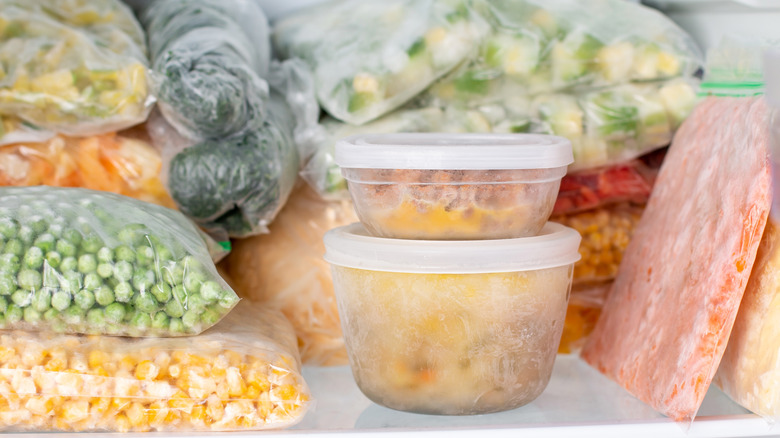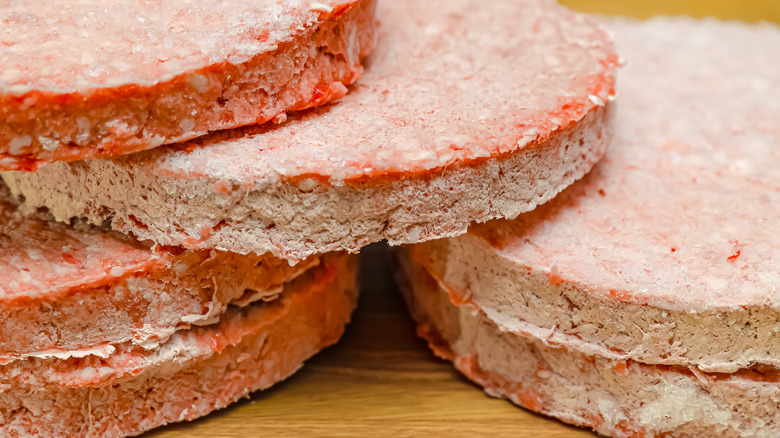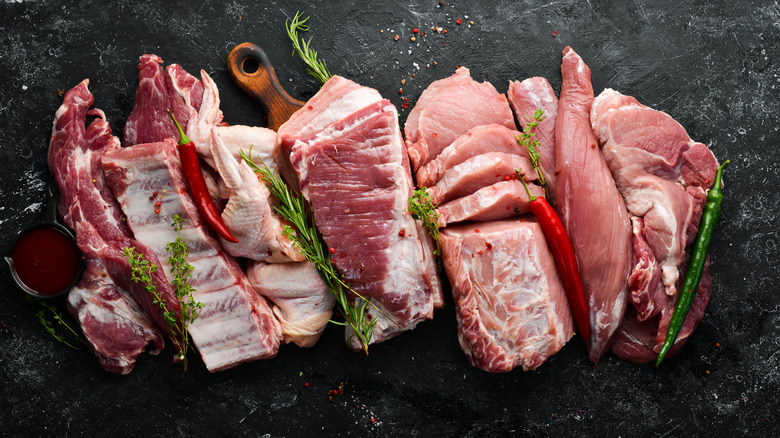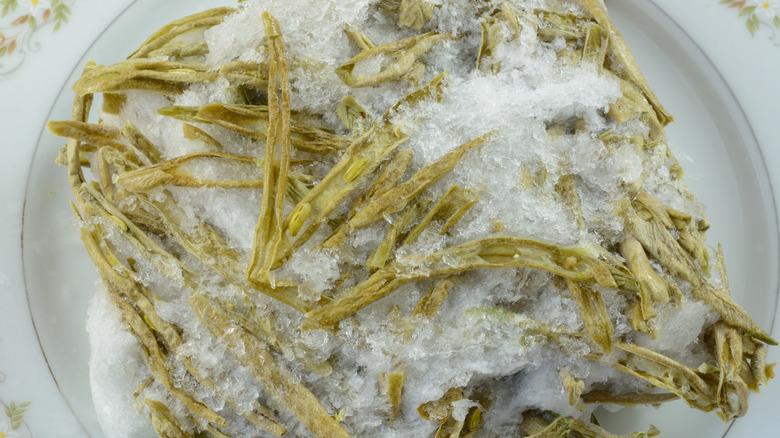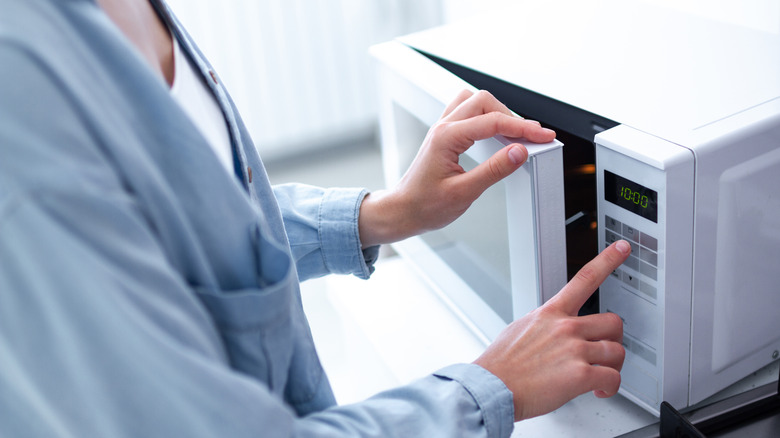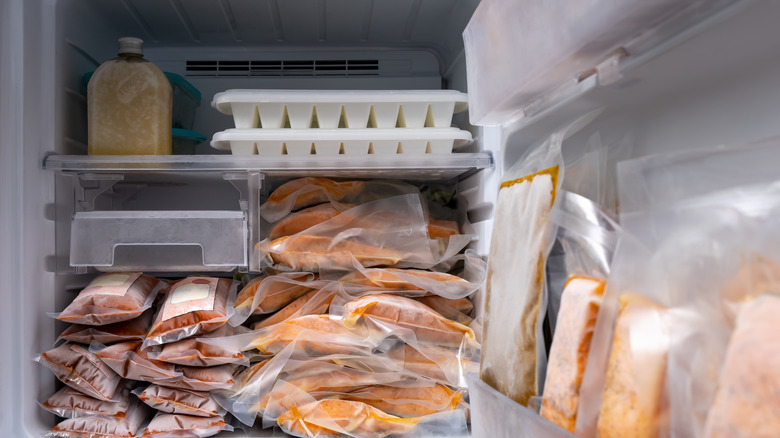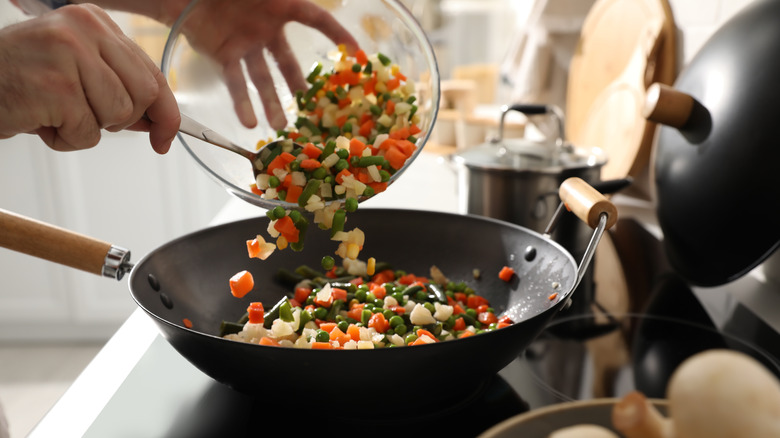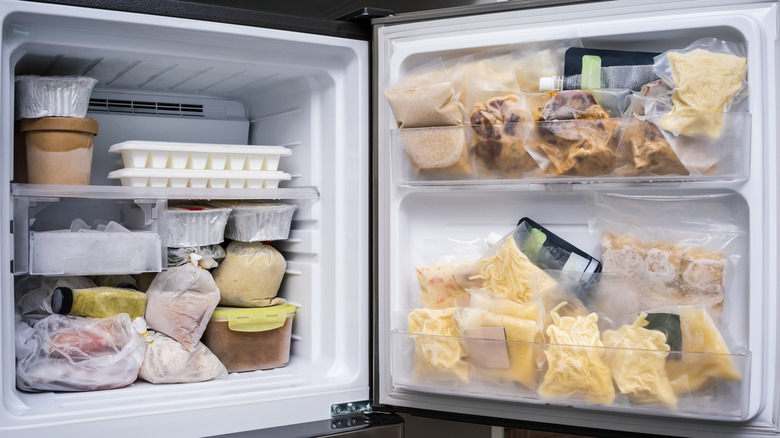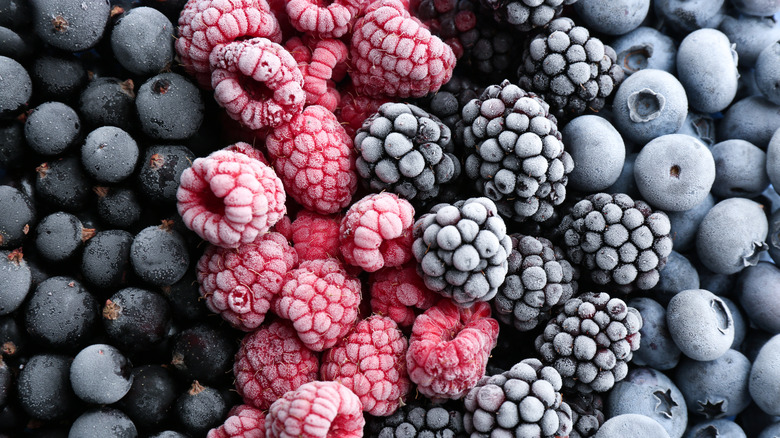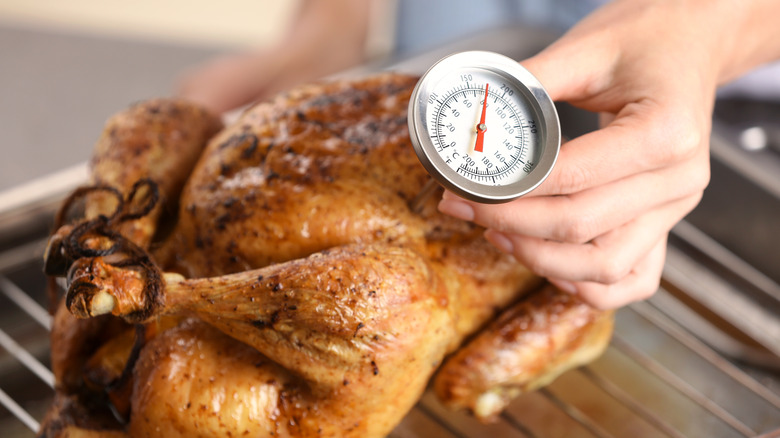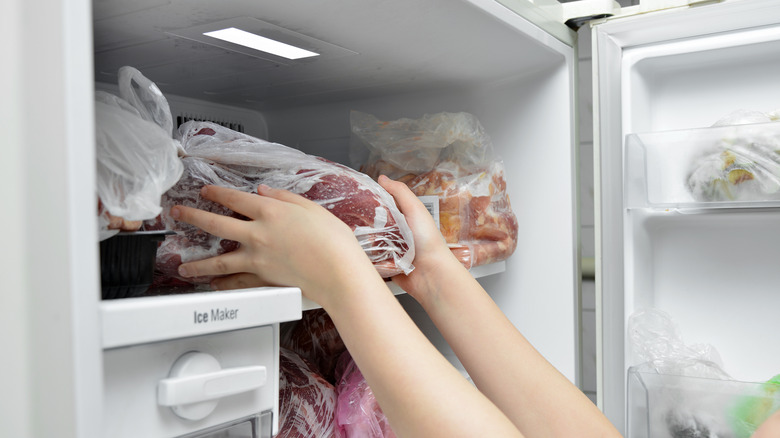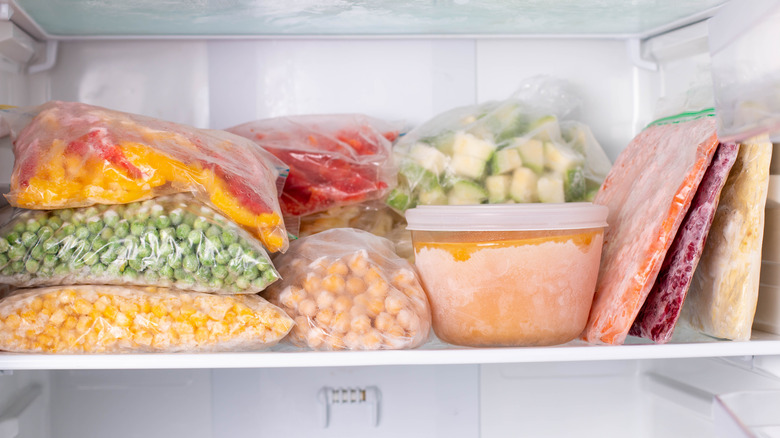Mistakes Everyone Makes With Frozen Food
Freezing food seems like a pretty simple task. All you have to do is take the food you want to freeze and pop it in the freezer, right? Well, sort of. While freezing your food isn't hard by any means, there are a few things to remember to ensure you're doing it correctly. Believe it or not, there are several mistakes everyone makes with frozen food, and we don't want you to fall into that category.
We want you to get the most out of your frozen food, especially after tackling that Pineapple, Cilantro, and Blackberry Vodka Ice Pops recipe. To ensure you are storing your frozen food correctly, we have compiled a list of things to consider so you are always eating the freshest, healthiest, and tastiest food possible. Freezing food isn't hard, but there is a kind of science to it. Here are some of the most common mistakes everyone makes with frozen food and why you won't want to make them.
Leaving food out on the counter at room temperature
When many of us take food out of the freezer to thaw out, we think placing it on the counter is a good idea. Sure, there seems to be some logic to it. However, allowing it to thaw at room temperature is easy and convenient since you just let it do its thing without putting in too much effort. This is a desirable thawing method, especially for anyone with a busy work schedule who wants to thaw something out while doing something else or leaving the house completely for a few hours.
However, thawing your frozen perishable food this way isn't the best option, says the USDA, and should never be left out on the counter longer than two hours. Once food hits what is referred to as the "danger zone" (which is a temperature within 40-140 degrees Fahrenheit), bacteria can start building, and it can be unsafe to eat. It's always a better idea to thaw frozen foods either in the refrigerator or in ice water.
Frozen foods aren't cooked thoroughly
We all know frozen foods take a little longer to cook than something fresh. But perhaps we aren't aware of just how vital cooking our frozen foods thoroughly really is to our health. According to Urban Citizen, frozen foods should be handled similar to raw foods in terms of cooking preparation since both can carry bacteria and, when not cooked all the way through, can be very harmful to your health.
To steer clear of any food-borne illnesses while cooking frozen (or raw) foods, ensure they are cooked properly. This means chicken and all ground meats, including beef and lamb, should be cooked at 165 degrees Fahrenheit while steak or pork can be cooked at 145 degrees Fahrenheit. Speaking of cooking foods properly, always check that your frozen meats (or any items in the freezer) have not been recalled so you aren't cooking anything you shouldn't be eating.
Foods aren't properly stored and have freezer burn
We've all been there. You're craving a few scoops of ice cream (say, from that Rainbow Cookie Ice Cream recipe you made the other day), but when you open your freezer, you see it's now covered in freezer burn. Talk about a total mood killer. No one wants to take frozen food from the freezer and see these icy crystals all over it.
When you store your food correctly, you can help prevent this, so your ice cream, veggies, or whatever is there will stay its best for your consumption. Whirlpool has said that freezer burn happens when cold, dry air hits the frozen foods, which usually occurs when they are not packaged and stored away correctly or left in the freezer for too long. For example, if you find your ice cream has freezer burn, this could be because the top was not securely placed on the carton. Always be sure everything is sealed correctly before you put it into the freezer.
Defrosting in the microwave
Hitting the defrost button on your microwave is a popular go-to for many of us trying to thaw our frozen food. However, it may not always be the best or the healthiest. Not only can using the defrost option in the microwave not always cook your food all the way through, but it can also ruin the taste of what you are trying to thaw. You want your food to thaw evenly, but doing so this way can do anything but that. Food can start to thaw along the edges, but the center can take much more time. This can be tricky when it comes to thawing frozen meats.
If you are planning to use the defrost button to thaw any meats, be sure to cook it immediately after it has thawed. This will help ensure no bacteria are growing in the food that can lead to food-borne illness and cause you to get sick.
Not accounting for freezer space
When it comes to our freezers, we tend to pack things in there. This is because it's convenient to keep food on hand without worrying about anything going bad if you aren't using them immediately. However, not considering your freezer space is one of the biggest mistakes everyone makes with frozen food.
You must have enough freezer space to account for all the foods you are putting in there. You want everything to stay secure and intact to remain fully frozen and without any freezer burn. Pack the food in your freezer correctly using flat freezer bags rather than bulky plastic containers, and divide items into serving sizes to help save on space. Other ways to ensure everything can fit in the freezer is by removing items from boxes, such as that ice cream cake you purchased for an upcoming party, and instead wrapping it in a freezer-safe bag.
Not heating frozen veggies correctly
We love having frozen veggies on hand to help whip up a quick and healthy meal. But while frozen vegetables can be convenient, it can sometimes be hard to master cooking properly. Sure, it seems easy enough: pop your frozen peas in the microwave to steam and be done. However, frozen vegetables can often come out soggy and end up lacking in flavor and texture.
Frozen veggies don't necessarily need much time (or any time for that matter) to thaw before the cooking process takes place. The texture changes as frozen veggies thaw which can cause them to grow soggy if left out to defrost. It doesn't take long for veggies to defrost since they are much smaller and not as thick as meat. Because of this, you can cook your frozen veggies so the structure stays intact, and you aren't risking a soggy, tasteless dish.
Freezing the wrong foods
Freezers are pretty impressive appliances. Not only can they accommodate your favorite ice cream, but freezers can also hold meats, fresh pastas, and so much more. While it's easy to pack your freezer with just about anything and everything you aren't planning to eat right away, some foods don't belong there. Adding the wrong items to your freezer is probably one of the biggest mistakes everyone makes with frozen food.
According to Mashed, anything with cornstarch, such as gravy, shouldn't be frozen as it thaws out in a decidedly more spongy texture rather than smooth and creamy. Never try to freeze eggs directly in the shells either, as they will only crack, and hardboiled eggs that are frozen come out rubbery after they are thawed out. Dairy products, such as milk and sour cream, should never be frozen as the texture will become grainy once thawed.
Not blanching frozen berries
There are many good reasons to want to freeze berries. Perhaps you're looking to keep your berries fresh when you're craving a healthy smoothie recipe or you want to ensure you have them on hand once they are no longer in season. Either way, freezing berries can work. Just make sure to freeze them in a single layer before dumping them in a freezer bag.
Once you're ready to use your frozen berries in your recipe, you must not forget to blanch them. According to WTOP News, placing the frozen berries in boiling water for a couple of minutes before allowing them to cool can help to prevent food-borne illness while still locking in the juicy, sweet and tart flavors. This technique is also essential when freezing corn and tomatoes. Place either in boiling water, then add to an ice bath before packing them in the freezer.
Not using a kitchen thermometer on frozen meats
When cooking meat, we may think we know when it's ready to eat simply by the way it looks. That is certainly not the case. If you aren't using a kitchen thermometer, you don't know if the meat is ready for safe consumption. The USDA says it's essential to use this handy gadget when cooking frozen meats, so you are not undercooking. If you undercook meat, it can have bacteria and be unsafe for you to eat.
A kitchen thermometer will tell you when the meat is cooked at the right internal temperature that is safe for you to consume and will help provide the best overall flavor and texture for optimal enjoyment. Typically, the thermometer should be placed in the thickest part of the meat to get the most accurate reading. Be sure to always to avoid the bone on any meat you are cooking.
The freezer isn't cold enough
If you open your freezer and see that your food appears to be frozen, you may think everything is working just fine. But not all temperatures are the right ones for your freezer, and if you don't have it cold enough in there, you can risk ruining the food that is packed and stored inside its frosty chambers.
According to the FDA, your freezer should be set to 0 degrees Fahrenheit to keep food stored safely without growing any unwanted bacteria that can be harmful to you. It's essential to check the freezer's temperatures often with appliance thermometers, so it stays where it needs to be. Keep in mind that if you should lose power, always check to see if the temperature is still around 40 degrees Fahrenheit or less. If so, your items are still safe to thaw, consume, or refreeze if needed.
Not freezing food right away
When many of us consider freezing food, we probably don't always think about when we should go do it. Instead, we may just pack the freezer with any items we aren't using and think we are done with it. Knowing when you should put items in the freezer is essential to keep your frozen food at its best. Not freezing items right away is one of the biggest mistakes everyone makes with frozen food. While you don't want to put anything that is still very hot into the freezer, you do want to make sure you are putting items in there as soon as possible.
According to USDA, it order to keep items at their freshest when it comes to thawing, you want to pop them in the freezer right away. By doing so you are helping to keep the food's flavor and the texture at its best. Fresh produce should not be overripe or underripe when placed in the freezer, says Mashed, but instead should be perfectly ripe to retain flavor.
